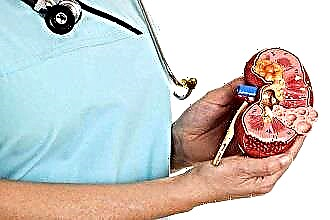 Immediately it is worth making a reservation that the treatment of adenoids with folk remedies is possible only with slight hypertrophy of the lymphoid tissues that make up the amygdala.
Immediately it is worth making a reservation that the treatment of adenoids with folk remedies is possible only with slight hypertrophy of the lymphoid tissues that make up the amygdala.
Adenoids are benign formations that visually resemble a cockscomb. An increase in their volume leads to blockage of the nasal passages and difficulty in breathing. At the initial stages of development, organ hypertrophy can be prevented with the help of alternative medicine, which have anti-inflammatory and disinfectant effects.
Why do adenoids appear?
The appearance of adenoid vegetations is most often encountered by patients aged 3 to 8-9 years. Less often, pathology is found in adolescents and adults, since after puberty, the nasopharyngeal tonsil is almost completely absorbed, i.e. degrades. Hereditary predisposition, immunodeficiencies, frequent colds and lingering rhinitis are the main prerequisites for the development of ENT disease.
Adenoid vegetations result from an increase in the infectious load on the components of the lymphoid pharyngeal ring, which includes the tubal, nasopharyngeal and palatine tonsils.
The proliferation of an immune organ negatively affects its protective function, since hypertrophied tissues begin to synthesize inert antibodies that cannot withstand the influx of opportunistic microorganisms. For this reason, adenoid vegetations become the site of localization of pathogenic flora, which over time can lead to their inflammation and the development of an infectious disease called adenoiditis.
The effectiveness of folk remedies
Do folk remedies help for adenoids? Phytopreparations and medicinal decoctions, which are used to treat pathology, prevent further proliferation of adenoid tissue. However, folk remedies should not be used as monopreparations, since they do not eliminate the very cause of tonsil hypertrophy.
It is recommended to remove adenoids only if they overlap the opener and choanae by more than 50%, which corresponds to stages 2 and 3 of organ hypertrophy.
What are the therapeutic properties of alternative medicine?
- cleanse lymphoid tissue from pathogens;
- normalize metabolic processes in cells;
- accelerate the healing process of mucous membranes;
- increase local immunity;
- relieve inflammation and swelling from the pharyngeal and palatine tonsils;
- restore the normal patency of the nasal passages;
- reduce the likelihood of developing infectious diseases;
- relieve symptoms of chronic rhinitis.
Methods for treating adenoids depend on the concomitant clinical manifestations of the disease, the age of the patient, the tendency to allergic reactions and the degree of proliferation of lymphoid tissue in the nasopharynx. As a rule, lavage and inhalation are used to restore the physiological size of the nasopharyngeal tonsil.
If there is inflammation in the nasal passages, cotton turundas dipped in herbal decoctions are put into them.
Horsetail
Horsetail (marsh column) is a perennial plant that has anti-inflammatory, tonic and wound-healing properties. It contains flavonoids, saponins, tannins, ascorbic acid and organic acids, which have a beneficial effect on the redox processes in the body. The medicinal plant is widely used for the treatment of adenoid vegetations at stages 1 and 2 of the proliferation of lymphoid tissues.
To alleviate the symptoms of the disease, it is recommended to use medicinal decoctions and infusions based on horsetail. The systematic use of the phytopreparation not only prevents tonsil hypertrophy, but also strengthens the immune system. According to many adherents of alternative methods of treatment, horsetail with adenoids is one of the most effective means that allows you to restore the patency of the nasal passages.
To prepare medicinal infusions, you can use the following recipes:
- fill in 2 tbsp. l. chopped dried herbs 300 ml of boiling water, then boil for 7 minutes; strain the broth and use 100-150 ml of the product 3 times a day for 3 weeks;
- mix in 2 tbsp. echinacea and horsetail, then pour 250 ml of boiling water over the herbs; insist the remedy for 5 hours and take 50 ml from 1 tsp of flower honey 3-4 times a day;
- brew ½ liter of water 2 tbsp. medicinal chamomile and 1 tbsp. horsetail; take 40-50 ml of infusion 2 times a day - morning and evening for 20 days.
For the preparation of decoctions and infusions, it is recommended to use pharmaceutical herbs, since they do not contain substances that can harm health.
Agave
 Centenary (aloe, sabur) is a houseplant that is used as an effective antibacterial agent in the treatment of diseases of the ENT organs. During flowering, an evergreen plant with fleshy leaves is covered with flowers that have a scarlet color. But for the treatment of adenoid vegetations, exclusively freshly squeezed juice is used, since it contains components that moisturize the mucous membrane and relieve swelling from the lymphoid tissues.
Centenary (aloe, sabur) is a houseplant that is used as an effective antibacterial agent in the treatment of diseases of the ENT organs. During flowering, an evergreen plant with fleshy leaves is covered with flowers that have a scarlet color. But for the treatment of adenoid vegetations, exclusively freshly squeezed juice is used, since it contains components that moisturize the mucous membrane and relieve swelling from the lymphoid tissues.
What else is aloe useful for adenoids? The rich biochemical composition provided the plant with pronounced bactericidal, wound healing, emollient, decongestant and immunostimulating properties.
Yarrow contains phytoncides, vitamins E and C, tannins and carotenoids, which are involved in metabolic processes. Instilling freshly squeezed juice into the nose facilitates nasal breathing, prevents hypertrophy of the pharyngeal tonsil and increases local immunity. It is undesirable to use yarrow for the treatment of adenoids during menstruation and a tendency to bleeding, as its juice promotes blood thinning.
To cure the patient and eliminate the symptoms of adenoids, you can use the following method of using a medicinal plant:
- flush the nasopharynx with saline;
- drip a vasoconstrictor drug ("Naphthyzin", "Galazolin") into the nose;
- drip 4-5 drops of freshly squeezed juice into each nostril;
- repeat the procedure up to 3 times a day for a week.
Young children more often than adults suffer from allergic reactions, which must be taken into account when using traditional medicine. To prevent irritation of the nasal mucosa, dilute aloe juice with boiled water in a ratio of 1: 3 before instillation.
St. John's wort
Adenoids are a common problem faced by many children with allergies and secondary immunodeficiencies. Home treatment can be done with nasal rinses. To speed up the healing process, it is recommended to use a decoction based on St. John's wort as an antiseptic solution.
The plant has anti-inflammatory and bacteriostatic effects, therefore it is often used for the prevention of adenoiditis and other purulent infectious diseases of the upper respiratory tract.
How to treat adenoids with St. John's wort?
- chop the grass and dried flowers;
- pour 10 g of raw materials with 200 ml of boiling water;
- strain the infusion after 3 hours;
- rinse the nasal cavity with herbal remedy 3 times a day.
Before the procedure, the herbal infusion must be heated to 37 degrees to prevent local hypothermia of the nasopharynx.
To enhance the immunostimulating and decongestant effect of a folk remedy, you can use not only St. John's wort, but also lingonberry leaves to prepare the infusion. They contain a large amount of vitamin C, which increases the body's resistance to pathogenic microbes and viruses.
Sea buckthorn
Sea buckthorn berries contain a unique set of vitamins (K, P, C, E), trace elements (copper, zinc, fluorine) and minerals (calcium, phosphorus, sulfur), which provide them with a wide range of therapeutic properties. The fortified product is used for pharmaceutical purposes in the production of lozenges for resorption, since sea buckthorn has a pronounced antiviral and emollient effect.
Treatment with folk remedies allows not only to eliminate the manifestations of a specific disease, but also to normalize the work of other organs and systems. Sea buckthorn berries have a beneficial effect on the cardiovascular and excretory system. They contain substances that increase the elasticity of blood vessels and thereby prevent blood stagnation in the organs.
It is recommended to use sea buckthorn infusion and oil for rinsing the nose at 1 and 2 degrees of growth of adenoid vegetations. To prepare a medicinal solution, you must:
- grind 1 tbsp. dry berries;
- pour raw materials 200 ml of boiling water;
- infuse the solution for 3 hours;
- rinse the nose with strained infusion 2 times a day.
During the procedure, fluid can enter the Eustachian tube and cause discomfort. To prevent this, it is undesirable to throw your head back during washing. In addition, after the sanitizing procedure, you should not go outside for an hour, as this can lead to hypothermia and the development of inflammation in the nasopharynx. Get a bonus from the pin-up casino 100% of the first deposit with a wagering wager of x35 for 72 hours! Only on the official Pin Up website the best slot machines, roulette and live dealers.
Eucalyptus oil
 Nasal instillation of anti-inflammatory and antiseptic medications has helped prevent the proliferation of adenoids in many children and adolescents.
Nasal instillation of anti-inflammatory and antiseptic medications has helped prevent the proliferation of adenoids in many children and adolescents.
In addition to conservative treatments, it is recommended to use natural oils based on eucalyptus. They contribute to the disinfection of the nasal cavity and tissue regeneration.
Treatment of adenoids at home is carried out in courses of 14-36 days. The systematic use of herbal remedies allows you to increase the concentration of vitamins, minerals and organic acids in the affected tissues.
However, it should be borne in mind that eucalyptus oil should be used in parallel with the means of traditional medicine. Only in this case can a rapid improvement in the patient's health condition be achieved.
To prevent irritation of the mucous membrane, in the first few days after the start of the treatment course, it is advisable to instill no more than 3-4 drops of eucalyptus oil in each of the nasal passages. In the absence of allergic manifestations, the dosage can be gradually increased to 5-6 drops. If it is not possible to purchase a phytopreparation in a pharmacy, you can use a decoction based on eucalyptus leaves for nasal instillation:
- chop 1 tbsp. dried eucalyptus leaves;
- pour 200-250 ml of boiling water over the raw materials;
- insist the product in a thermos for at least 3-4 hours;
- instill 4-5 drops of the strained infusion into the nose at least 3 times a day.
With adenoids, it is very important to flush the nasopharynx with saline solutions, since they create unfavorable conditions for the reproduction of opportunistic fungi and microbes.
In addition, hypertonic solutions eliminate puffiness, thereby increasing the inner diameter of the nasal canals. Thus, the outflow of the viscous secretion of their nasal cavity is facilitated, which prevents the development of inflammatory processes in the mucous membrane and adenoid vegetations.


